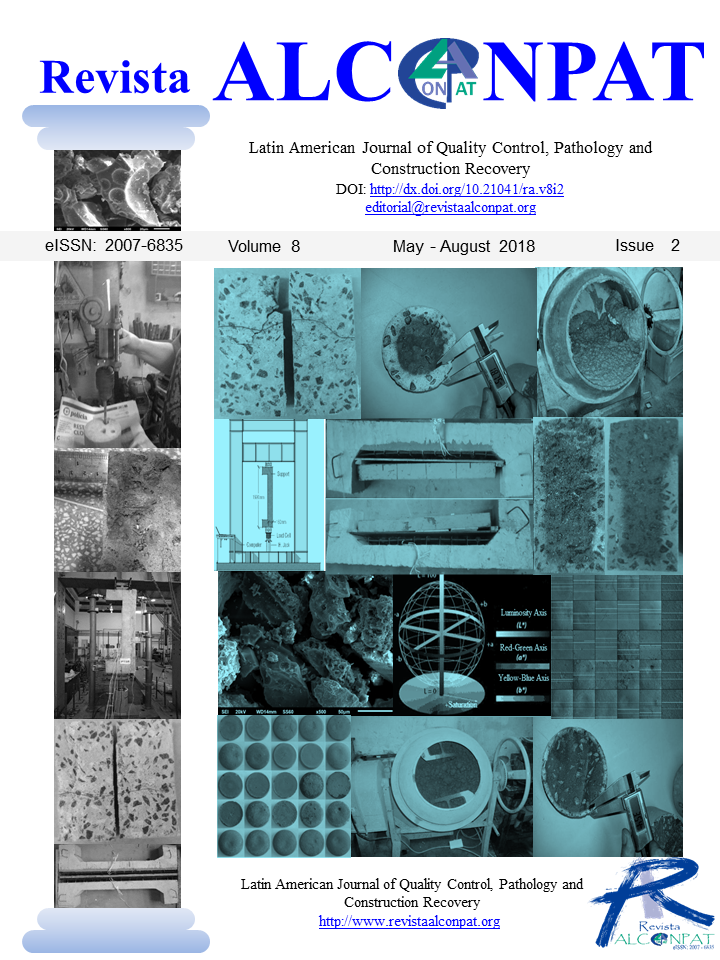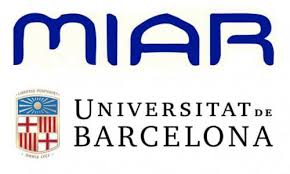Verifying chloride penetration in concrete test samples partially immersed in seawater in Recife, Pernambuco
Abstract
The objective of this research is to analyze, using chemical tests, the quantity of chloride ions in concretes with different traces (proportions of materials) in their depths. To do so, tests were performed in laboratories, and test samples were made with partial immersion in seawater, in accordance with the standards and Mohr method. The results confirmed that the penetration percentage of chloride ions is less for the rich trace, in relation to the others test samples studied. Accordingly, it is concluded that the stronger the concrete the greater the penetration resistance of chloride ions, but these results are to be expected, since the concrete with greatest strength and same materials tends to hinder the entry of those ions.
Downloads
References
ABNT - Associação Brasileira de Normas Técnicas (2009), NBR 7211/2009: Agregados para concreto - Especificação. Rio de Janeiro: ABNT.
ABNT – Associação Brasileira de Normas Técnicas (2014), NBR 6118/2014: Projeto de Estruturas de Concreto - Procedimento. Rio de Janeiro.
ABNT – Associação Brasileira de Normas Técnicas (1991), NBR 11578/91: cimento Portland composto - Especificação. Rio de Janeiro: ABNT.
ABNT – Associação Brasileira de Normas Técnicas (2012), NBR-9779/2012: Argamassa e concreto endurecidos — Determinação da absorção de água por capilaridade. Rio de Janeiro: ABNT.
Andrade, C., Sagrera, J. L., Sanjuán, M. A. (1999), “Several years study on chloride ion penetration into concrete exposed to Atlantic Ocean water”, In: 2nd International Rilem Workshop on Testing and Modelling the Chloride Ingress into Concrete, Eds. C. Andrade, J. Kropp, Paris, CD.
Andrade, J. J. O. (2001), Contribuição à previsão da vida útil das estruturas de concreto armado atacadas pela corrosão de armaduras: Iniciação por cloretos. Tese de doutorado. Escola de Engenharia, Universidade Federal do Rio Grande do Sul. Porto Alegre, 249 p.
Cascudo, O., Carasek, H. (2014), Durabilidade do concreto: bases científicas para a formulação de concretos duráveis de acordo com o ambiente. 1. ed. São Paulo, SP: IBRACON.
Google Maps (2017). Disponível em: http://embrasil.s3.amazonaws.com/upload/ciudad/81C-37.jpg. Acesso em: 11/07/2017
Helene, P. R. L. (1986), Corrosão das Armaduras para Concreto Armado. São Paulo, IPT, PINI.
Helene, P., Medeiros, M. (2008), Concreto armado versus ambiente marítimo: por que proteger e o que considerar para especificar?. São Paulo, Concreto e Construções, IBRACON, v.35, p.23-8.
International Organization for Standardization (2013), ISO TC 71/SC 1 - Testing methods for Concrete.
International Organization for Standardization (2013), ISO/WD 1920-11 - Testing of Concrete - part 11: Determination of the Chloride Resistance of Concrete, Unidirectional Diffusion.
Lima, M. G., Morelli, F. (2005), Mapa brasileiro de "chuva dirigida" - Algumas considerações. In: Simpósio Brasileiro de Tecnologia de Argamassas, 6.
Mehta, P. K., Monteiro, P. J. M. (2014), Concreto: microestrutura, propriedades e materiais. 2. ed. São Paulo, SP: IBRACON. pp: 751.
Meira, G. R. (2009), Comportamento do aerosol marinho e sua relação com estruturas de concreto em zona de atmosfera marinha. In: Jornadas de Engenharia - Tecnologia do Concreto e Patologia das Estruturas, 2009, Fortaleza. Anais das Jornadas de Engenharia - Tecnologia do Concreto e Patologia das Estruturas. Fortaleza: UVA / UNIFOR. v. 1.
Mota, A. C. M. (2011), Avaliação da presença de cloretos livres em argamassa através do método colorimétrico de aspersão da solução de nitrato de prata, Dissertação de Mestrado em Engenharia Civil, Universidade de Pernambuco.
Medeiros, M. H. F., Real, L. V., Richter, K., Souza, W. B., Klein, N. S. (2014), Ensaios de migração de cloretos em estado estacionário para avaliação de sistemas de proteção de superfície. REEC - Revista Eletrônica de Engenharia Civil, v. 8, p. 54-63. https://doi.org/10.5216/reec.v8i2.27155
Medeiros, M. H. F., Hoppe Filho, J., Borba, A. Y., Helene, P. (2012), Ensaio de migração de cloretos para concreto: influência do número de fatias extraídas. REM. Revista Escola de Minas (Impresso), v. 65, p. 475-481. http://dx.doi.org/10.1590/S0370-44672012000400007
Medeiros, M. H. F., Pereira, E., Helene, P. (2012), Tratamento de superfície com silicato de sódio para concreto: penetração de cloretos e absorção de água. Revista ALCONPAT, v. 2, n. 3, p. 156-161. http://dx.doi.org/10.21041/ra.v2i3.34
Meck, E., Sirivivatnanon, V. (2003), Field indicator of chloride penetration depth. Cement and Concrete Research, v. 33, n. 8, p.1113-1117. https://doi.org/10.1016/S0008-8846(03)00012-7
Otsuki, N., Nagataki, S., Nakashita, K. (1992), Evaluation of AgNO3 Solution Spray Method for Measurement of Chloride Penetration into Hardened Cementitious Matrix Materials. ACI Materials Journal, v. 8, n. 6, p. 587-592, 1992. Technical paper.
Pintan, N. M., Berenguer, R. A., Da Costa E Silva, A. J., Lins, C. M. M. S., Monteiro, E. C. B. (2015), Pathological Manifestations and The Study of Corrosion Present on Bridges on the City of Recife. The Electronic Journal of Geotechnical Engineering, v. 20, p. 11893-11907.
Verás Ribeiro, D., Sales, A., Caldas de Sousa, C. A., do Couto Rosa Almeida, F., Teixeira Cunha, M. P., Zita Lourenço, M., Helene, P. (2014), Corrosão em estruturas de concreto armado: teoria, controle e métodos de análise. Rio de Janeiro: Campus.
_______________________________
License in effect from September 2020
You are free to:
- Share — copy and redistribute the material in any medium or format for any purpose, even commercially.
- Adapt — remix, transform, and build upon the material for any purpose, even commercially.
- The licensor cannot revoke these freedoms as long as you follow the license terms.
Under the following terms:
- Attribution — You must give appropriate credit , provide a link to the license, and indicate if changes were made . You may do so in any reasonable manner, but not in any way that suggests the licensor endorses you or your use.
- No additional restrictions — You may not apply legal terms or technological measures that legally restrict others from doing anything the license permits.
Notices:
You do not have to comply with the license for elements of the material in the public domain or where your use is permitted by an applicable exception or limitation .
No warranties are given. The license may not give you all of the permissions necessary for your intended use. For example, other rights such as publicity, privacy, or moral rights may limit how you use the material.





















.png)














